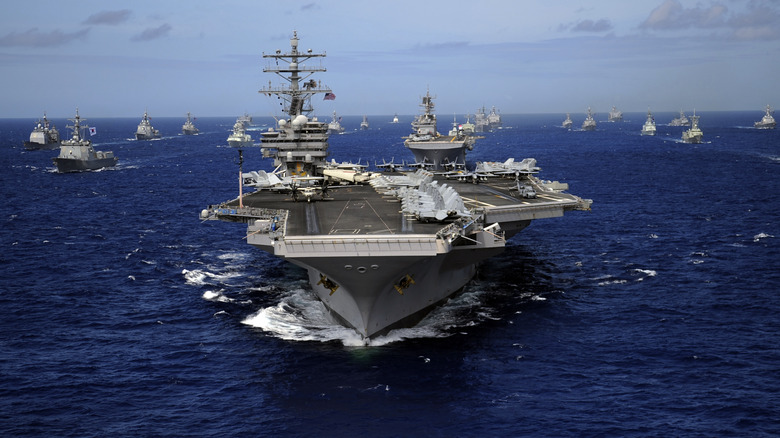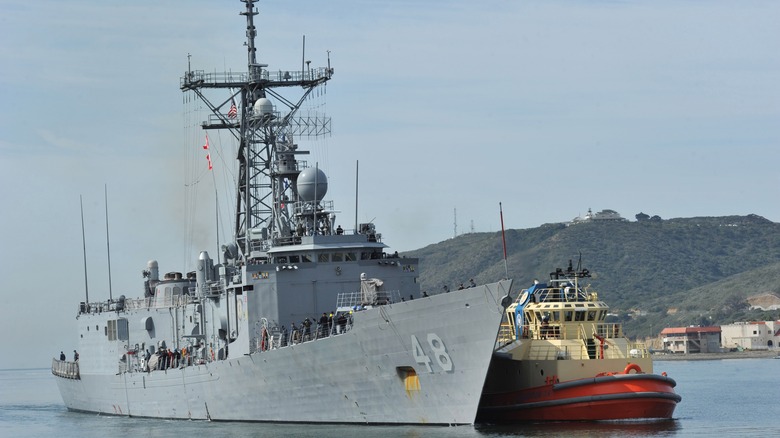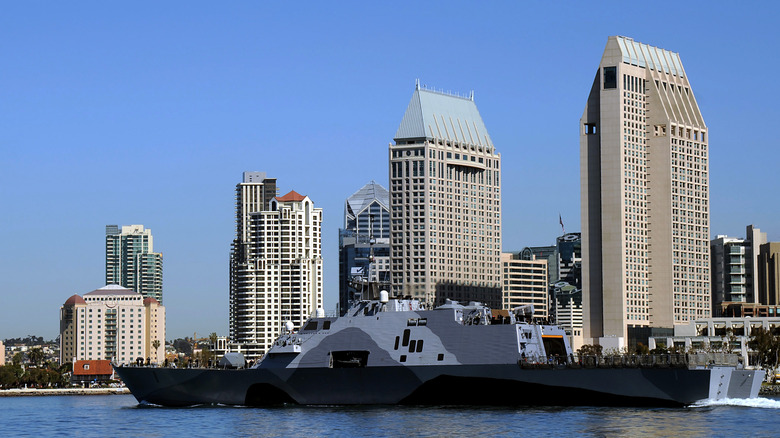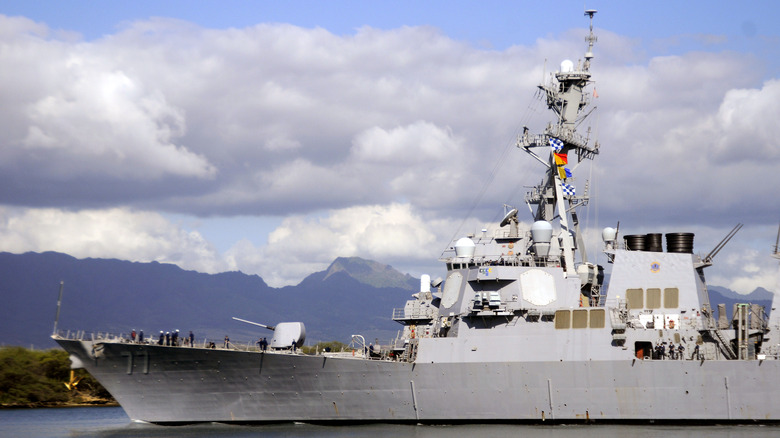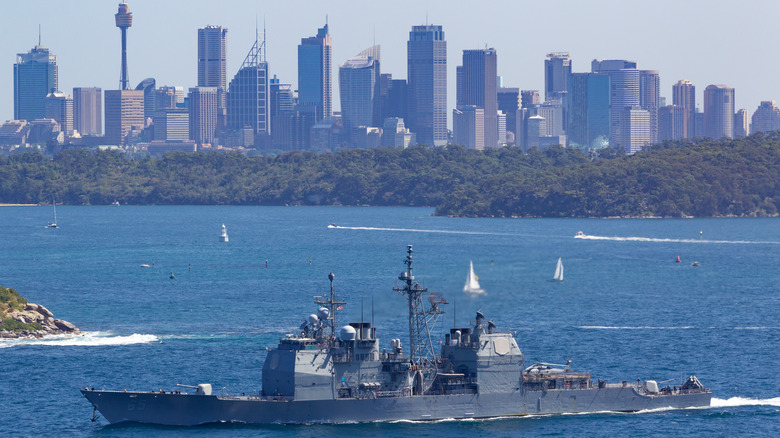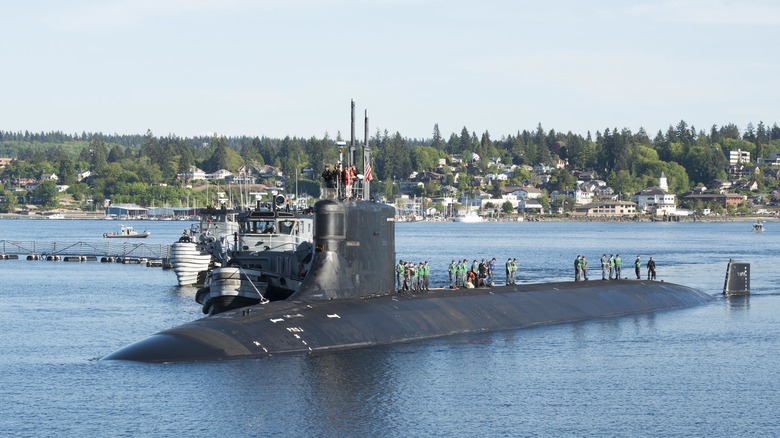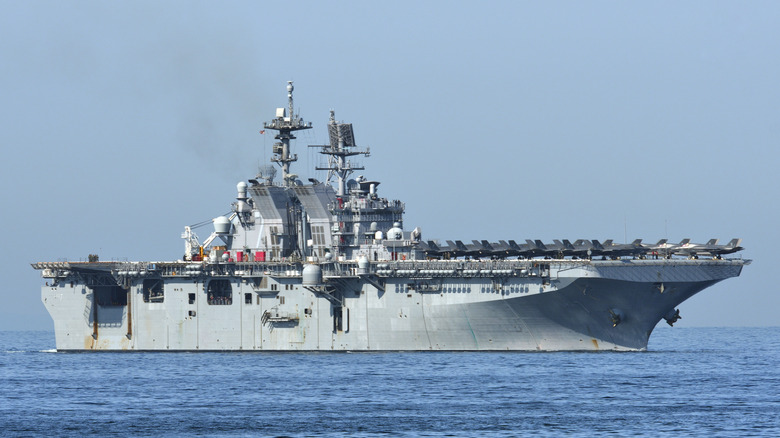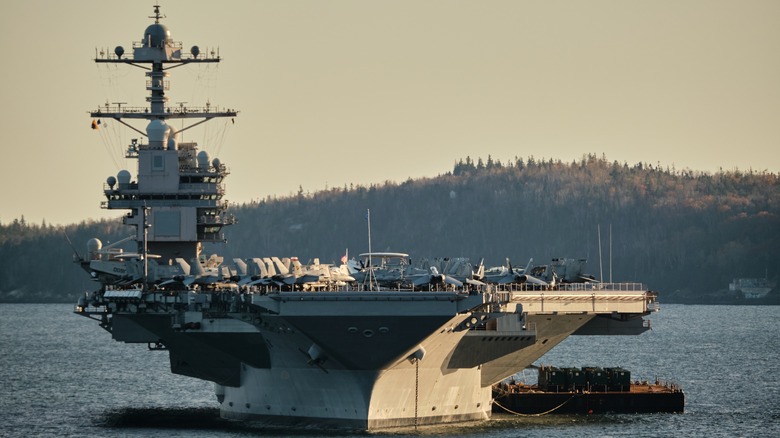The 7 Types Of Modern Warships Explained
Naval warfare can be a captivating subject, evoking images of mighty vessels navigating vast oceans, locked in strategic battles, and defending the interests of nations. From legendary ships of the past to the sleek warships of today, the evolution of naval warfare is a testament to our pursuit of maritime exploration and supremacy. Modern navies have a wide variety of ships to fulfill different roles in today's ever-changing military landscape. Military ships can come in all shapes and sizes. Although different countries may have different names for them, all modern military ships typically fall within seven categories. These include Frigates, Corvettes, Destroyers, Cruisers, Submarines, Amphibious Warfare Ships, and Aircraft Carriers.
Each type of warship plays an important role in overall naval operations, allowing for versatility and effective missions. Some may never leave their home ports and spend their time patrolling nearby shores, some provide immediate humanitarian relief, while others have enough firepower to level a city. As we explore these different types of modern warships, we'll look at the historical significance of each, the technological advancements that each has undergone over the years, and the purpose it plays in the fleet.
These warships give us valuable insights into the pivotal role these vessels have played in shaping the balance of power on the global stage. Here we will delve into the depths of naval warfare and tell the stories behind the seven types of modern warships, their contributions, and their enduring impact on naval power.
Frigates
Throughout naval history, the term "frigate" has been applied to various types of ships, encompassing a range of classifications. From traditional sailing vessels with masts to modern guided missile escorts, the concept of a frigate has evolved significantly over time. In the present era, frigates are larger than Corvettes or shore patrol boats but have less armament compared to Destroyers or Cruisers.
During World War II, frigates played a crucial role as an intermediary between Corvettes and Destroyers/Cruisers. Corvettes lacked the necessary resources to operate effectively in extended open-water missions. Frigates were designed to be faster than corvettes while also possessing sufficient armament for anti-submarine operations. Although they did not have the same firepower as Cruisers or Destroyers, their primary objective was to escort and engage vulnerable submarines that were forced to resurface.
The Oliver Hazard Perry-class warship served as the final active service frigate in the United States Navy (USN). However, all active duty ships of this class were decommissioned in 2015. This decision was prompted by the emergence of a new ship class, known as the Littoral Combat Ship (LCS), which assumed the previous roles of frigates. Presently, the USN is exploring a return to the frigate designation through a newly awarded design contract to Fincantieri. This upcoming frigate class is currently referred to as the Constellation class frigate and is expected to enter production and service in the coming years.
Corvettes
Corvettes are nimble and high-speed vessels frequently employed as coastal patrol boats. While the corvette designation may vary across countries, these ships are typically restricted to operating in close proximity to naval bases and are seldom deployed independently in open waters.
These vessels are renowned for their ability to swiftly respond to threats along a nation's coastlines, making them valuable assets for fast attack and response missions. A significant advantage of corvette-class ships lies in their compact size and exceptional speed. Due to their smaller dimensions, they do not necessitate specialized naval engineering docks like carriers or cruisers. Instead, smaller engineering bays can be utilized, facilitating easier mass production.
Although the United States Navy (USN) does not presently possess any ships specifically designated as corvettes, there are several smaller ship classes that fall within a similar category. Notably, the larger patrol boats operated by the U.S. Coast Guard exhibit characteristics and capabilities akin to corvettes, even if they lack the specific designation. Additionally, the LCS (Littoral Combat Ship) class of vessels served as a temporary replacement for frigates and corvettes.
LCS ships can be classified as corvette-style warships as well. Certain newer models of LCS ships were initially intended to succeed frigates, but following field testing, issues including exceeding budgetary limits and failing to deliver promised capabilities emerged. Consequently, the majority of LCS ships were decommissioned, and all future production of this class has been halted.
Destroyers
Destroyers played a significant role as fast attack ships during World War II, primarily serving as escort vessels attached to battle groups. With their ability to carry torpedoes and effectively hunt submarines, they were essential assets in naval warfare. However, the landscape of naval tactics and doctrines underwent a substantial transformation with the widespread adoption of modern guided missiles.
In the immediate post-World War II period, destroyers boasted greater speed than Cruisers, although they were comparatively less armored and equipped with less advanced onboard technology. They relied on escort ships for advanced logistics and tracking capabilities but compensated with enhanced firepower, torpedoes, and anti-submarine mines. Their specific missions during World War II necessitated specialized design and functionality. Destroyers were required to be swift to close in on enemy ships and deliver rapid strikes, resulting in thinner armor plating and a focus on ship-killing weaponry like torpedoes.
The advent of guided missiles has largely rendered armor obsolete, as modern missiles possess the capability to penetrate most conventional armor plating. Consequently, the need for heavily armored warships has diminished. This shift has enabled both destroyers and cruisers to be equipped with comparable equipment and armor, thereby aligning their operational capacities. Modern destroyers continue to fulfill a range of functions as escorts. However, many have evolved into mobile missile platforms, armed with guided missile launchpads. This transformation allows them to serve both offensive and defensive roles, significantly augmenting their capabilities in modern naval warfare.
Cruisers
Cruisers are renowned as some of the largest and most heavily armored surface attack ships in modern navies. Their size and armament surpass that of carriers, which primarily rely on aircraft for their weaponry. Following World War II, the line between cruisers and destroyers has blurred significantly. Traditionally, cruisers were characterized by their powerful armor and offensive capabilities. However, with the advent of guided missiles in warfare, heavily armored ships were rendered less relevant. Consequently, cruisers shifted their focus from armor to missile platforms and torpedo launchers. Although today's modern cruisers feature reduced armor, they remain highly lethal vessels. Many of these cruisers are equipped with vertical launch missile systems, a main gun, and various smaller gun placements.
Present-day cruisers serve vital offensive roles on the battlefield. In addition to their potent offensive capabilities, many modern cruisers have advanced electronic countermeasures and defensive systems, often functioning as ballistic missile defense platforms. Despite evolving over time, cruisers maintain their significance within naval fleets. They continue to be optimized for combat effectiveness and multi-role operations, serving as the backbone of numerous navies worldwide.
Submarines
Submarines have undergone notable advancements since World War II, particularly with the integration of nuclear reactors. This revolutionary addition has addressed one of the primary drawbacks of submarines. Previously, diesel-powered submarines had to resurface periodically, rendering them vulnerable to enemy attacks. In contrast, modern nuclear-powered submarines have the capability to generate their own water and oxygen, enabling them to remain submerged for extended periods and operate independently.
Furthermore, the enhanced power supplied by nuclear reactors has facilitated the construction of larger submarines equipped with multiple missile racks. The pioneering efforts of Admiral Hyman George Rickover, overseeing the development of the world's first nuclear submarines, earned him the title of the "Father of the Nuclear Navy." Recognizing their combat potential, Rickover also predicted that submarines could eventually render other ship types obsolete, envisioning a future where all naval missions could be effectively handled by these underwater vessels.
Modern submarines serve a diverse range of roles, including counter surveillance, radar operations, escort duties, asset insertion, and functioning as mobile missile platforms. With their ability to submerge underwater and remain undetected for extended durations, they have become one of the most lethal and efficient warships on the seas today, second only to aircraft carriers. Their versatility and strategic advantages make them indispensable assets within any fleet.
Amphibious warfare ships
Contrary to the name, Amphibious warfare ships are not all designed to operate on dry land. Their primary purpose is to swiftly transport significant quantities of ground equipment, such as trucks, tanks, and troops, from ships to shore. Amphibious vehicles come in various sizes and configurations, especially the Wasp-class vessels. Although they may resemble carriers due to their impressive size, they are smaller and fulfill different operational roles.
The USS Makin Island and similar Amphibious warfare ships serve as transport and command vessels. During operations, they have the capacity to deliver approximately 1,800 fully equipped ground troops, along with vehicles and any other resources required to establish a base of operations anywhere in the world. The amphibious fleet of the U.S. Navy operates closely in conjunction with the Marines, with their primary objective being the rapid deployment of Marines to any theater of operations. Thanks to their global base coverage and the support of amphibious warships, Marines can establish a beachhead on any coast within a matter of days.
In addition to larger amphibious craft like the Wasp-class ships, there are several smaller landing craft that fall under the amphibious classification. These vessels can be driven onto shore to offload equipment and troops. Examples include the Amphibious Assault Vehicle (AAV), which resembles a tank and can operate on both land and water, and the Land Craft Utility vehicle (LCU), which can be beached and deploy ramps for the quick disembarkation of small vehicles and troops.
Aircraft carriers
The widespread adaptation of aircraft carriers since World War II has brought about a marked transformation in naval warfare. Alongside the introduction of guided missiles, carriers have rendered battleships completely obsolete, exerting dominance over modern navies ever since. Modern carriers are colossal vessels equipped with cutting-edge technology, resembling small floating cities with a crew capacity of approximately 5,000 personnel. Currently, the world's largest carrier is the newly commissioned Gerald R. Ford class, which replaced the long-standing Nimitz class.
The Gerald R. Ford class represents a pinnacle of Carrier engineering, incorporating advanced electronics and modern technology throughout its construction. Unlike its predecessor, the Nimitz, this class does not rely on outdated internal systems like steam lines. By leveraging these advancements, the carriers can achieve equivalent operational capabilities with approximately 500 fewer crew members.
Aircraft carriers today serve a diverse array of missions such as mobile attack and defense platforms, operating various wing groups. Their mobility also places carriers as rapid response forces, capable of swift deployment. Moreover, carriers are frequently called upon for diplomatic endeavors, as few assets demonstrate diplomacy more prominently than a multi-billion dollar floating weapon platform anchored off the coast of a foreign nation. Carriers also play a vital role in disaster relief and humanitarian missions. Their modern capabilities enable them to provide power to affected areas, provide food for thousands, and produce roughly 200,000 gallons of potable water daily. These capabilities make carriers invaluable assets in addressing crises and delivering aid on a global scale.
